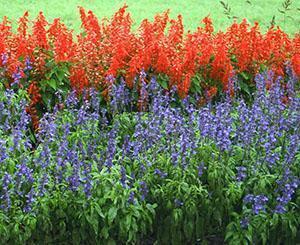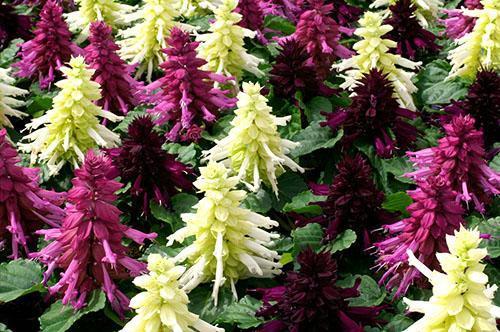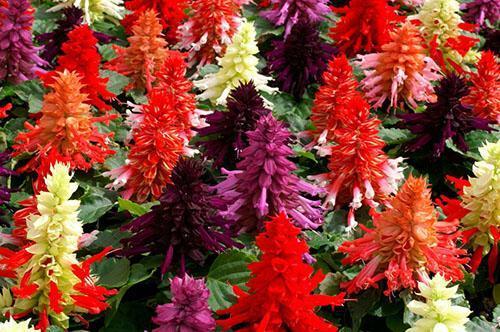Flowerbed in red-azure tones: types and varieties of salvia for the garden
 It is difficult to imagine flower gardens in personal plots and city flower beds without catchy spike-shaped inflorescences of salvia. Long and lush blooming plants, not demanding on the soil and wateringare familiar to most gardeners. But few suspect that several hundred species and varieties of Salvia for the garden belong to the genus to which the brilliant Salvia belongs. Among them is medicinal sage.
It is difficult to imagine flower gardens in personal plots and city flower beds without catchy spike-shaped inflorescences of salvia. Long and lush blooming plants, not demanding on the soil and wateringare familiar to most gardeners. But few suspect that several hundred species and varieties of Salvia for the garden belong to the genus to which the brilliant Salvia belongs. Among them is medicinal sage.

The leaves of many salvia varieties are elongated, whole or, much less often, feathery. The color of flowers is not limited to the bright red familiar today. It is rather an exception to the rule. Wild species are striking in the richness of the palette from white to deep purple, and therefore are of increasing interest to flower growers. But according to the established tradition, the name "Salvia" is firmly entrenched in the varieties of sparkling salvia, and plants with blue tassels are called sage.
Salvia sparkling: photo of Salvia splendens flowers
 The most famous of the garden species of Salvia is a native of Brazil, used in culture for almost 200 years. At home, bushes or herbaceous plants with rigid erect tetrahedral stems can reach 20–80 cm in height and bloom en masse during the summer and autumn.
The most famous of the garden species of Salvia is a native of Brazil, used in culture for almost 200 years. At home, bushes or herbaceous plants with rigid erect tetrahedral stems can reach 20–80 cm in height and bloom en masse during the summer and autumn.
Before the start of active breeding work, brushes of brilliant Salvia, the photos of flowers of which today amaze with the richness of colors and splendor of inflorescences, were not so spectacular. At the disposal of gardeners were only varieties with red corollas and cups, loosely sitting on the peduncle.
Today, in addition to red flowers, one can increasingly find brilliant white, purple lilac and even two-tone salvia.
Salvia officinalis (Salvia officinalis)
 Medicinal salvia - sage, well known to people for thousands of years, is used in medicine, perfumery and cooking. The homeland of the plant is the states of the Mediterranean and the region of Asia Minor. Under favorable conditions, the perennial shrub reaches half a meter in height, and in Russia it can be grown only through seedlings as an annual crop.
Medicinal salvia - sage, well known to people for thousands of years, is used in medicine, perfumery and cooking. The homeland of the plant is the states of the Mediterranean and the region of Asia Minor. Under favorable conditions, the perennial shrub reaches half a meter in height, and in Russia it can be grown only through seedlings as an annual crop.
Sage is easily distinguished by its elongated silvery leaves and purple flowers gathered in sparse vertical inflorescences.
A medicinal species of Salvia and garden varieties with variegated leaves, bloom in the middle of summer.
Salvia red (Salvia coccinea)
 Red salvia in the photo of flowers is very similar to both medicinal sage and its more spectacular congener - brilliant salvia. A semi-shrub from Brazil in European countries and Russia is cultivated as an annual, but in this case the plant grows to 50–70 cm.
Red salvia in the photo of flowers is very similar to both medicinal sage and its more spectacular congener - brilliant salvia. A semi-shrub from Brazil in European countries and Russia is cultivated as an annual, but in this case the plant grows to 50–70 cm.
This species has straight pubescent stems with ovoid leaves and carmine-red flowers, collected on sparse spike-shaped inflorescences of 5-8 pieces. Corollas, no more than 3 cm long, bloom in the middle of summer, and the plant retains its decorative effect until the very cold weather.If we compare red salvia with brilliant varieties, then the first loses in brightness, although it is used by flower growers for a hundred years longer.
Today, interest in the moisture-loving Salvia, which prefers sun and warmth, is constantly growing. The plant reproduces well by seeds and can be planted both in open ground and in greenhouses.
Small-leaved salvia (Salvia microphylla)
 This species of salvia - sage in its wild form is still found in southern Europe, France and the Mediterranean countries. Here it is a perennial evergreen plant that grows up to 100–120 cm. Salvia blooms from June to late October.
This species of salvia - sage in its wild form is still found in southern Europe, France and the Mediterranean countries. Here it is a perennial evergreen plant that grows up to 100–120 cm. Salvia blooms from June to late October.
But small brushes of carmine flowers are not the only characteristic feature of the species. The greens and stems of the evergreen shrub contain many aromatic essential oils used by perfumers and doctors.
Mealy salvia (Salvia farinacea)
 Picky, blooming from August to the end of autumn, the plant appeared in Russian flower gardens from Central America. Mealy salvia has little branching straight stems up to 90 cm high. Inflorescences reach 20 cm in length and effectively rise above neat pyramidal bushes.
Picky, blooming from August to the end of autumn, the plant appeared in Russian flower gardens from Central America. Mealy salvia has little branching straight stems up to 90 cm high. Inflorescences reach 20 cm in length and effectively rise above neat pyramidal bushes.
The cups, corollas and the upper part of the peduncle are painted in blue or purple tones, which persist even when the plants are dried.
The leaves are elongated, ovoid and, unlike many species and varieties of salvia for the garden, do not have a characteristic edge.
Salvia motley (Salvia viridis)
 The value of this native of the south of Europe and Asia is not in bright inflorescences or essential oils, but in variegated brightly colored leaves-bracts on the upper part of 40- or 60-centimeter stems. Oblong leaves and shoots are pubescent.
The value of this native of the south of Europe and Asia is not in bright inflorescences or essential oils, but in variegated brightly colored leaves-bracts on the upper part of 40- or 60-centimeter stems. Oblong leaves and shoots are pubescent.
Inflorescences reach 30 cm and combine up to 6 medium-sized flowers of pinkish or light lilac hue. Salvia or sage begins to bloom in June, and the appearance of the plant remains throughout the growing season. The only feature that makes it difficult to use variegated forms in culture is lodging of the stems, if supports are not installed in time.
Salvia verticillata (Salvia verticillata)
 The whorled variety of sage in its wild form is found throughout Russia, in Western Europe and some regions of Asia. You can recognize the few varieties of salvia by the purple flowers collected in dense whorls located on high peduncles. The stems of this species branch only at the base and grow up to 50 cm in height. The leaves, like the shoots, are heavily pubescent and are attached to the stems on long petioles.
The whorled variety of sage in its wild form is found throughout Russia, in Western Europe and some regions of Asia. You can recognize the few varieties of salvia by the purple flowers collected in dense whorls located on high peduncles. The stems of this species branch only at the base and grow up to 50 cm in height. The leaves, like the shoots, are heavily pubescent and are attached to the stems on long petioles.
Whorled salvia begins to bloom in July, and until September its elegant inflorescences can be seen in forest glades and personal plots.
Clary sage (Salvia sclarea)
 Vigorous plants of one meter in height are grown in annual or biennial crops. On straight stems, studded with oblong, jagged leaves along the edges. This type of salvia produces an abundant green mass. Leaves sometimes reach a length of 30 cm, but as they move towards the inflorescence they become smaller.
Vigorous plants of one meter in height are grown in annual or biennial crops. On straight stems, studded with oblong, jagged leaves along the edges. This type of salvia produces an abundant green mass. Leaves sometimes reach a length of 30 cm, but as they move towards the inflorescence they become smaller.
The decorativeness of the plant is given not by nondescript flowers, but by bracts. Today there are varieties of Salvia with white, pink or purple corollas. Blooming from June to September, the sage species is well known as a valuable medicinal and essential oil plant.
Salvia oak (Salvia nemorosa)
 The sage species growing in the zone of the Russian forest-steppe has powerful stems up to 30–60 cm high and dense, candle-like inflorescences reaching 40 cm in length. Both corollas and large bracts are purple or azure in color.
The sage species growing in the zone of the Russian forest-steppe has powerful stems up to 30–60 cm high and dense, candle-like inflorescences reaching 40 cm in length. Both corollas and large bracts are purple or azure in color.
If hairs are noticeable on the stems, then the long pointed leaves of Salvia Oakravna are completely smooth with teeth along the edges. The decorativeness of the plant lasts from mid-summer to mid-September.
Salvia meadow (Salvia pratensis)
 The plant, half a meter high, is distinguished by many straight, branching stems and peduncles covered with purple corollas.Meadow sage is similar to oak salvia, but the latter is much more powerful, and its shoots are not so branched. In each whorl, from 4 to 6 flowers are attached, occasionally small leaves can be seen on the stems, which become much larger towards the root rosette.
The plant, half a meter high, is distinguished by many straight, branching stems and peduncles covered with purple corollas.Meadow sage is similar to oak salvia, but the latter is much more powerful, and its shoots are not so branched. In each whorl, from 4 to 6 flowers are attached, occasionally small leaves can be seen on the stems, which become much larger towards the root rosette.
The meadow sage blooms in two waves. The first, like many species and varieties of salvia for the garden, begins in June, and the second bloom revives the site in September.